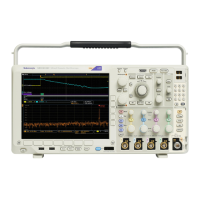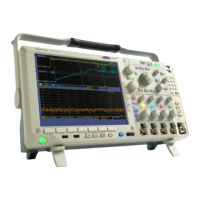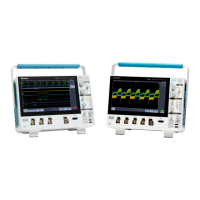Commands Listed in Alphabetical Order
Arguments
AC specifies AC t
rigger coupling,
DC specifies DC trigger coupling, which passes all input signals to the trigger
circuitry.
HFRej specifies high-frequency rejection coupling, which attenuates signals
above 50 kHz before passing the signals to the trigger circuitry.
LFRej specifies low-freque
ncy rejection coupling, which attenuates signals below
50 kHz before passing the signals to the trigger circuitry.
NOISErej specifies noise-rejection coupling, which provides stable triggering
by increasing the trigger hysteresis. Increased hysteresis reduces the trigger
sensitivity to noise but may require greater trigger signal amplitude.
Examples
TRIGGER:A:EDGE:COUPLING DC sets the A edge trigger coupling to DC.
TRIGGER:A:EDGE:COUPLING? might return :TRIGGER:A:EDGE:C OUPLING
DC
indicating that the A edge trigger coupling is set to DC.
TRIGger:A:EDGE:SLOpe
This command specifies the slope for the A edge trigger: rising, falling or either.
NOTE. A series of e xample command sequences showing different searches and
triggers is included as an appendix. (See page F-1, Search and Trigger Command
Sequence Examples.)
Group
Trigger
Syntax
TRIGger:A:EDGE:SLOpe {RISe|FALL|EITHer}
TRIGger:A:EDGE:SLOpe?
Related Commands
TRIGger:A:EDGE:SOUrce,
TRIGger:A:EDGE:COUPling
Arguments
RISe specifies to trigger on the rising or positive edge of a signal.
FALL specifies to trigger on the falling or negative edge of a signal.
EITHer specifies to trigger on either the rising or falling edge of a signal.
Examples
TRIGGER:A:EDGE:SLOPERISE sets the A edge trigger slope to positive, which
triggers on the rising edge of the signal.
MDO4000/B/C, MSO/DPO4000B and MDO3000 Series Oscilloscopes Programmer Manual 2-875

